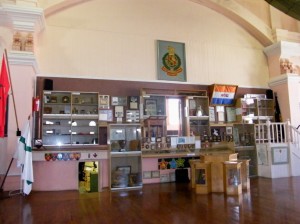 I had to pop into the Prince Alfred’s Guard Museum to other day to take some pics for a brochure. I’ve actually never been in the museum before then, although I know the monument at St Georges Park quite well. The museum houses military exhibits in the Regiment’s Victorian Drill Hall (built in 1880). It is a national monument and one of the finest surviving examples of its type.
I had to pop into the Prince Alfred’s Guard Museum to other day to take some pics for a brochure. I’ve actually never been in the museum before then, although I know the monument at St Georges Park quite well. The museum houses military exhibits in the Regiment’s Victorian Drill Hall (built in 1880). It is a national monument and one of the finest surviving examples of its type. I got the following history and information about the Prince Alfred’s Guard of Wikipedia:
Prince Alfred’s Guard was established on 19 September 1856 as the Port Elizabeth Volunteer Rifle Corps. In 1860 the title Prince Alfred’s Guard was assumed unofficially (after Prince Alfred, Duke of Edinburgh) and on 11 July 1874 this name was officially sanctioned as Prince Alfred’s Volunteer Guard. The name was later changed to Prince Alfred’s Guard.
The Regiment first saw action on 2 December 1877, against the Gcaleka tribesmen in the Battle of Umzintzani during the Ninth Xhosa War. The next conflict that the PAG participated in was the Basutoland Campaign of 1880 to 1881, during which a 500 metre bayonet charge by the Regiment which led to the capture of the village of Lerotholi, an enemy village. The Regiment also took part in the Bechuanaland Campaign of 1897.
The Regiment also served in the Second Anglo-Boer War of 1899 to 1902 – as mounted infantry – and took part in campaigns in the Orange Free State and the South African Republic.
Members of the PAG volunteered for service in World War I, but there was dissension in the ranks after a long deployment on sentry duty in Cape Town. As a result the contingent was disbanded and most of its members saw active service during the war in other South African units.
In 1913 the regiment was redesignated the 3rd Infantry Regiment (Prince Alfred’s Guard) of the Active Citizen Force of the Union Defence Force, but regained its former name in 1934.
During World War II, the regiment first served as link battalion for the 2nd Brigade, South African Infantry in North Africa, sending drafts of men to the fighting units, among which many went to the Field Force Battalion. The PAG was subsequently converted to an armoured unit and saw further active service with the 11th South African Armoured Brigade, South African 6th Armoured Division in Italy as a tank unit.
The PAG also took part in the many skirmishes making up the South African Border War during the post-war period.
The Regiment first saw action on 2 December 1877, against the Gcaleka tribesmen in the Battle of Umzintzani during the Ninth Xhosa War. The next conflict that the PAG participated in was the Basutoland Campaign of 1880 to 1881, during which a 500 metre bayonet charge by the Regiment which led to the capture of the village of Lerotholi, an enemy village. The Regiment also took part in the Bechuanaland Campaign of 1897.
The Regiment also served in the Second Anglo-Boer War of 1899 to 1902 – as mounted infantry – and took part in campaigns in the Orange Free State and the South African Republic.
Members of the PAG volunteered for service in World War I, but there was dissension in the ranks after a long deployment on sentry duty in Cape Town. As a result the contingent was disbanded and most of its members saw active service during the war in other South African units.
In 1913 the regiment was redesignated the 3rd Infantry Regiment (Prince Alfred’s Guard) of the Active Citizen Force of the Union Defence Force, but regained its former name in 1934.
During World War II, the regiment first served as link battalion for the 2nd Brigade, South African Infantry in North Africa, sending drafts of men to the fighting units, among which many went to the Field Force Battalion. The PAG was subsequently converted to an armoured unit and saw further active service with the 11th South African Armoured Brigade, South African 6th Armoured Division in Italy as a tank unit.
The PAG also took part in the many skirmishes making up the South African Border War during the post-war period.

Interesting history — what are all the items in the display cases?Three Rivers Daily Photo
Why is the old South African flag up? Is it because that's the flag that was in use at that time?
The items are all memorabelia such as badges, awards, medals, ect. The old SA flag has some discription with it explaining it. I just can't remember what it was. Next time I'm there I'll check and make a note.
Nice photo and infos! Well, the Oranje-Blanje-Blou will be there because it was the last official national flag that was valid at the time the regiment was still in action.ps.: I've added a link to this page in a travel community where I'm member – hope it's fine.